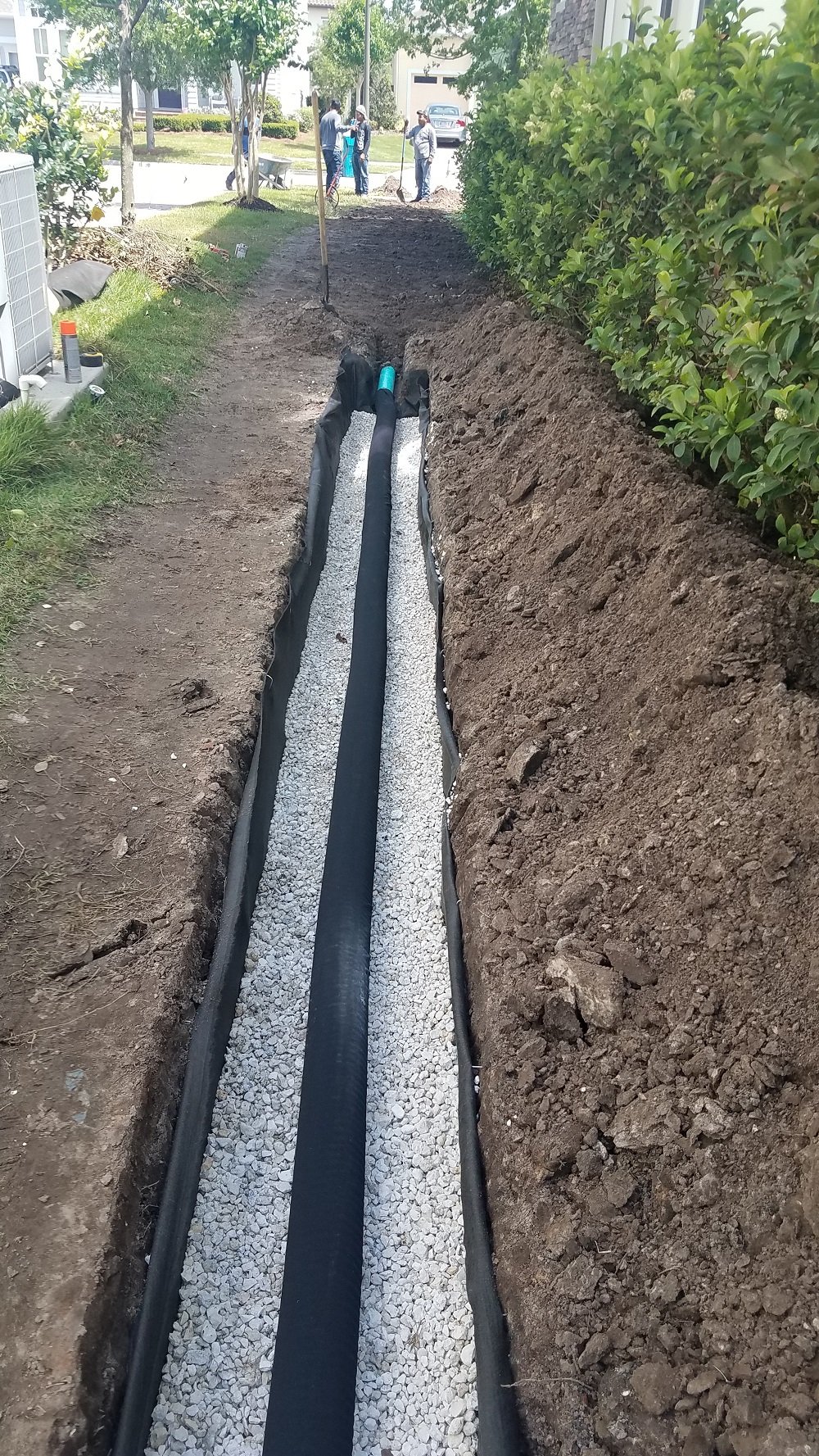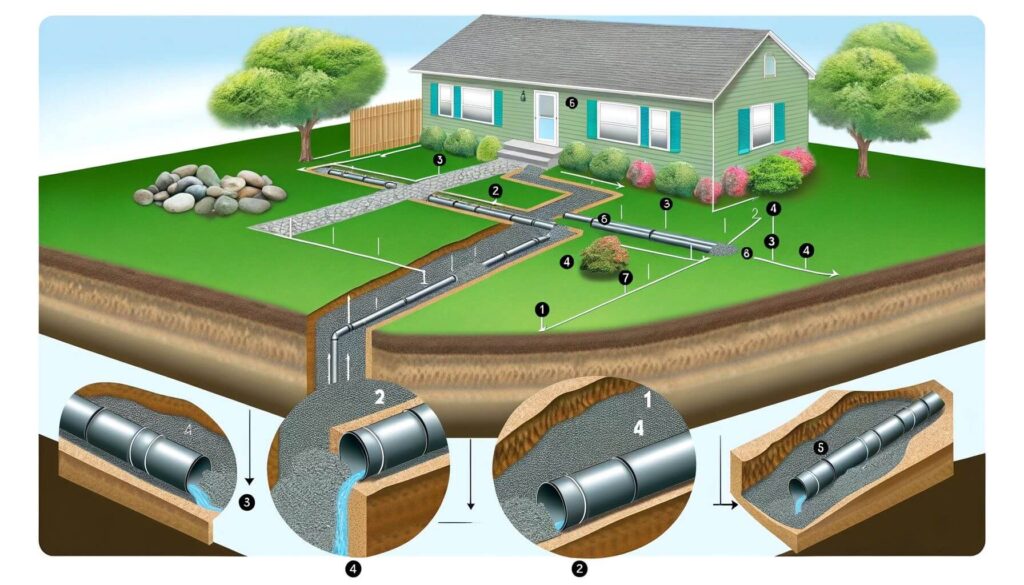Keep Your Cellar Dry with an Expertly Installed French Drain System
Keep Your Cellar Dry with an Expertly Installed French Drain System
Blog Article
Understanding the Importance of a Septic System French Drain for Effective Wastewater Management
The assimilation of a septic system French drainpipe system plays a critical role in efficient wastewater administration, yet its significance is frequently overlooked. This system not just assists in the treatment of sewer however also successfully handles excess water, reducing potential environmental threats. Understanding the technicians and benefits of such a system can brighten its important role in preventing dirt saturation and enhancing groundwater top quality. Disregarding its maintenance can lead to severe complications that might threaten these advantages. What are the details challenges one might encounter without this important element?
What Is a Sewage-disposal Tank French Drainpipe?
A septic tank French drain is a specialized drainage system developed to manage wastewater and avoid flooding in areas where conventional drainage methods may be inadequate. This system incorporates the functionalities of a conventional septic system with a French drain, enabling efficient wastewater treatment and reliable water diversion.

Created making use of perforated pipelines laid in crushed rock trenches, a French drain promotes the activity of water away from important locations. It permits the infiltration of excess water into the surrounding soil, advertising reliable water drainage while shielding the septic tank's stability. The combination of these 2 systems is specifically beneficial in areas with hefty rainfall or poor water drainage, making certain the durability and performance of wastewater management systems while safeguarding public wellness and the atmosphere.

How It Works in Wastewater Monitoring
In wastewater management, the integration of a septic system and French drain plays an essential role in guaranteeing reliable treatment and disposal of sewage. The sewage-disposal tank acts as the initial line of protection, where wastewater goes through preliminary treatment through sedimentation and anaerobic digestion. Solids work out at the bottom, forming sludge, while lighter products, such as oil and oils, float to the top, producing a scum layer. This process lowers the natural tons of the wastewater before it moves forward.
Once the wastewater is made clear, it moves into the French drainpipe system, which is created to help with more treatment and safe dispersal. The French drainpipe includes perforated pipelines buried in crushed rock or stone, permitting treated effluent to percolate right into the surrounding dirt. This natural purification process help in the removal of nutrients and microorganisms, promoting groundwater recharge and minimizing the threat of surface area contamination.
With each other, the septic tank and French drainpipe produce a sustainable approach to wastewater monitoring, reducing ecological impact while ensuring compliance with wellness policies. This incorporated system not just safeguards public wellness yet also keeps the integrity of neighborhood communities.
Advantages of a French Drain System

The French drainpipe system uses numerous advantages that enhance both wastewater monitoring and environmental management. Mostly, it efficiently reroutes water away from essential areas, reducing the danger of flooding and dirt saturation that can jeopardize septic tanks. This positive drainage remedy assists maintain the honesty of the septic system by stopping excess moisture, which can result in system failing.
Furthermore, a properly installed French drain reduces the potential for groundwater contamination. By channeling wastewater away from the property, it minimizes the chance of pollutants getting in regional water resources, hence securing public health and wellness and keeping environmental equilibrium. The system additionally improves the looks and functionality of outdoor areas by protecting against water accumulation, which can create muddy areas or unpleasant puddles.
Additionally, French drains pipes call for reasonably reduced upkeep contrasted to various other water drainage solutions, making them an affordable long-lasting investment. Their adaptability permits them to be made use of in numerous landscapes, suiting both industrial and property homes. Eventually, the advantages of a French drain system expand past prompt drain requirements, contributing to sustainable wastewater management practices and promoting environmental stewardship.
Common Issues Without a French Drainpipe
Neglecting the installation of a French drain can click here for more info cause considerable challenges in managing water flow and keeping soil integrity. One of the key concerns is the build-up of excess surface water, which navigate to this site can create merging or swamping in lawns, especially after heavy rains. This torpidity can saturate the dirt, resulting in disintegration and jeopardizing the foundation of neighboring structures.
Moreover, without a French drainpipe, groundwater can improperly penetrate septic systems, increasing the danger of system failure. The resulting back-up can result in unpleasant smells, health hazards, and expensive repair work. Poor water drainage can likewise advertise the growth of mold and mildew and mildew, which can adversely impact interior air high quality and pose wellness risks to occupants.
Ultimately, the lack of a French drain can result in a range of environmental and structural issues that require considerable treatment and cost to remedy. Applying a French drainpipe system is critical for effective wastewater management and residential or commercial property security.
Maintenance Tips for Homeowners
Routine maintenance of a French drainpipe is crucial to guarantee its ideal efficiency and durability. If sediment is existing, think about using a high-pressure water jet to get rid of the drain.
Additionally, it is crucial to maintain the area around the French drainpipe devoid of particles, useful content such as leaves, dirt, and other raw material. This will prevent obstructing and enable effective water drain. Routinely trimming plant life and growing far from the drainpipe can also alleviate origin invasion.
Additionally, property owners need to keep an eye on the performance of their French drainpipe after hefty rainfall. Observing how well water is routed away from the septic tank can supply insights right into its performance. It might indicate a requirement for specialist assessment. if merging water is kept in mind.
Finally, consider scheduling periodic expert inspections to examine the general problem of the drainpipe. Such proactive procedures will certainly help maintain the effectiveness of your French drainpipe and ensure effective wastewater administration for several years to come.
Final Thought
In final thought, the septic container French drain system plays an essential duty in reliable wastewater management by making certain proper treatment of sewage and effective water diversion. On the whole, the septic storage tank French drainpipe represents a lasting service that profits both property and industrial properties across different landscapes.
The integration of a septic storage tank French drain system plays a pivotal duty in efficient wastewater management, yet its value is commonly neglected. Inevitably, the advantages of a French drainpipe system prolong past prompt drainage demands, contributing to sustainable wastewater administration methods and promoting environmental stewardship.
In addition, without a French drain, groundwater can poorly infiltrate septic systems, enhancing the danger of system failing - French Drain System. Implementing a French drain system is important for effective wastewater management and home defense
In final thought, the septic container French drainpipe system plays an essential duty in reliable wastewater monitoring by ensuring correct therapy of sewage and effective water diversion.
Report this page